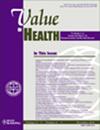用于决策的基因组效用的标准化测量和评估尺度:guv尺度。
IF 4.9
2区 医学
Q1 ECONOMICS
引用次数: 0
摘要
目标:基因组学对临床医生、患者、家庭和社会具有多方面的价值,这对决策者制定优先级决策具有重要意义。本研究旨在建立一个标准化、累积和偏好加权的基因组效用评估(GUV),范围为0-100%。方法:在澳大利亚,参与政策、临床、研究和消费者倡导领导的专家进行了多标准决策分析(MCDA),以评估基因组效用的政策优先指标。通过一个风格化的例子说明了使用guv量表来支持政策决策,并通过将导致澳大利亚基因组测试公共报销的现实世界卫生技术评估的证据映射到guv量表来确定基因组效用的基准评分阈值。结果:共邀请专家33人(73%)参与研究。临床效用的优先级最高,其次是社会、诊断、经济和家庭效用。改善健康结果的偏好值最高(29.5%),其次是改善公平(22.6%)、具有高诊断率(22.2%)、改善症状管理(15.5%)、节省成本(14.3%)、具有平均诊断率(13.1%)、能够获得临床试验(12.3%)和能够实现生殖计划生育(11.5%)。现实世界hta的基因组测试分数从综合征和非综合征性智力残疾的46%到线粒体疾病和遗传性肾病的约60%不等。结论:在不同的临床背景下比较基因组效用似乎很困难,因为需要权衡多个标准来支持政策决定。这种比较现在以一种标准化的方式与guv量表相结合。本文章由计算机程序翻译,如有差异,请以英文原文为准。
A Standardized Measurement and Valuation Scale of Genomic Utility for Policy Decisions: The GUV Scale
Objectives
The multifaceted ways in which genomics can be valuable to clinicians, patients, families, and society are important for informing prioritization decisions by policy makers. This study aims to develop a standardized, cumulative, and preference-weighted genomic utility valuation (GUV) on a scale of 0% to 100%.
Methods
A multicriteria decision analysis was conducted with experts involved in policy, clinical, research, and consumer advocacy leadership in Australia for the valuation of policy priority indicators of genomic utility. The use of the GUV scale to support policy decisions is illustrated through a stylized example, and benchmark scoring thresholds of genomic utility were identified by mapping evidence from real-world health technology assessments leading to the public reimbursement of genomic testing in Australia onto the GUV scale.
Results
In total, 33 (73%) invited experts participated in the study. Clinical utility had the highest priority, followed by societal, diagnostic, economic, and family utilities. Improving health outcomes had the highest preference value (29.5%), followed by improving equity (22.6%), Having high diagnostic yield (22.2%), improving symptom management (15.5%), being cost saving (14.3%), having average diagnostic yield (13.1%), enabling access to clinical trials (12.3%), and enabling reproductive family planning (11.5%). Genomic testing scores from real-world health technology assessments ranged from 46% for syndromic and nonsyndromic intellectual disability to about 60% for mitochondrial conditions and genetic kidney diseases.
Conclusions
Comparisons of genomic utility across different clinical contexts may seem difficult because of the multiple criteria required to be weighted to support policy decisions. This comparison is now facilitated in a standardized manner with the GUV scale.
求助全文
通过发布文献求助,成功后即可免费获取论文全文。
去求助
来源期刊

Value in Health
医学-卫生保健
CiteScore
6.90
自引率
6.70%
发文量
3064
审稿时长
3-8 weeks
期刊介绍:
Value in Health contains original research articles for pharmacoeconomics, health economics, and outcomes research (clinical, economic, and patient-reported outcomes/preference-based research), as well as conceptual and health policy articles that provide valuable information for health care decision-makers as well as the research community. As the official journal of ISPOR, Value in Health provides a forum for researchers, as well as health care decision-makers to translate outcomes research into health care decisions.
 求助内容:
求助内容: 应助结果提醒方式:
应助结果提醒方式:


